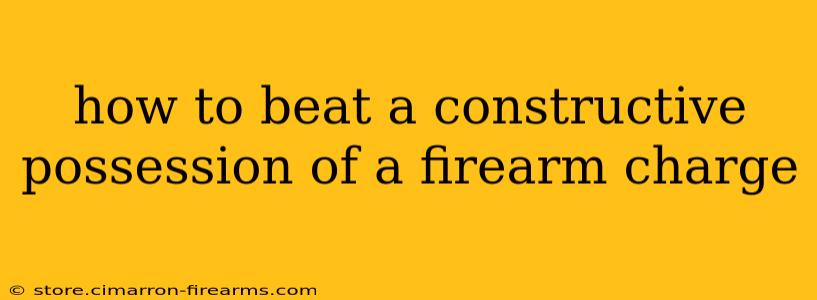Facing a constructive possession of a firearm charge is a serious matter with potentially severe consequences. This charge alleges you exercised control or dominion over a firearm, even if you didn't directly possess it. Successfully defending against this charge requires a thorough understanding of the law and a robust legal strategy. This article outlines key approaches and considerations, but remember, this is not legal advice. You must consult with a qualified criminal defense attorney in your jurisdiction for personalized guidance.
Understanding Constructive Possession
Constructive possession means you had the power and intent to control a firearm, even without physically holding it. Prosecutors must prove beyond a reasonable doubt that you had:
- Knowledge: You knew the firearm was present.
- Control: You had the ability to exercise dominion and control over the firearm.
- Intent: You intended to exercise that control.
This differs from actual possession, where the firearm is directly on your person or in your immediate control. Constructive possession cases often hinge on circumstantial evidence, making a strong defense crucial.
Strategies for Beating a Constructive Possession Charge
Successfully defending against this charge requires a multi-pronged approach focusing on challenging the prosecution's evidence and highlighting weaknesses in their case. Here are some key strategies:
1. Challenging the Knowledge Element
The prosecution must prove you knew the firearm was present. Your defense might focus on:
- Lack of awareness: You were unaware of the firearm's existence in the location. This might involve demonstrating you didn't have access to the area where it was found or that others had unrestricted access.
- Denial of knowledge: You deny any knowledge of the firearm's presence. This requires a strong and consistent defense.
2. Challenging the Control Element
Demonstrating a lack of control is vital. Consider these arguments:
- Joint occupancy: If the firearm was found in a shared space (e.g., a house, car), argue that others had equal or greater access.
- Lack of proximity: Show you weren't near the firearm or in a position to control it.
- Lack of association: If the firearm was found near you, demonstrate you had no connection to it.
3. Challenging the Intent Element
The prosecution needs to prove you intended to exercise control. Argue:
- Lack of intent: You had no intention to control or use the firearm. This could involve demonstrating you were unaware of its presence or had no reason to believe it was there.
- Innocent explanation: Provide a reasonable explanation for your presence near the firearm or in the location where it was found.
4. Challenging the Evidence
Scrutinize the prosecution's evidence meticulously:
- Chain of custody: Challenge the integrity of the evidence by questioning the chain of custody. Any breaks in the chain weaken the prosecution's case.
- Witness credibility: Challenge the credibility of witnesses, highlighting potential biases or inconsistencies in their testimonies.
- Lack of forensic evidence: If there's a lack of forensic evidence linking you to the firearm, highlight this absence.
Building a Strong Defense
Building a strong defense involves:
- Immediate legal counsel: Contact a skilled criminal defense attorney immediately. Timely legal intervention is crucial.
- Gathering evidence: Collect any evidence that supports your defense, such as witness statements, photos, or alibi evidence.
- Cooperation with your attorney: Fully cooperate with your attorney and provide all relevant information.
Remember, navigating the complexities of a constructive possession charge requires expert legal guidance. The penalties for this offense can be severe, including substantial fines and imprisonment. Do not attempt to navigate this alone. Seek immediate legal counsel from a qualified criminal defense attorney to protect your rights and build the strongest possible defense.

